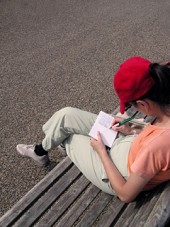The Art of Keeping a Travel Journal
Interview by Rolf Potts
by Lavinia Spalding (google+)I was going through some old boxes the other day when I found a beat up old notebook that contained a journal of my trip to the Philippines almost nine years ago. The journey had been my first to a tropical country, and thumbing through those wrinkled pages was like stepping into a blast of Southeast Asian humidity: The more I read, the more I began to feel the emotions I felt when I first wandered through Manila and Cebu and Boracay.
Admittedly, the prose in my old journal was far too purple and unfocused to submit for publication in the greater world, but it was a wonderfully vivid evocation of the trip, by myself and for myself -- an author and audience of one.
My travel journals haven't been quite so detailed in the years since I returned from the Philippines -- mainly due to the professional demands of travel writing, which takes up most of my note-taking time on the road. Moreover, since a lot of my leftover travel perspectives have gone electronically into my blog in recent years, my pen and paper travel journals have been a bit skimpy in recent years.
Nevertheless, I believe that keeping a travel journal can be one of the most rewarding habits a person can keep on the road. Since I'm a bit out of practice, however, I got in touch with my old friend Lavinia Spalding -- a Utah-based writer and travel-journal guru currently at work on a book titled, "Writing Away: A Creative Guide to Journaling on Vacation" -- to winnow out some expert advice on keeping a journal on the road:
Rolf Potts: What are the benefits of keeping a travel journal? Why not just enjoy your experience organically without recording it?
Lavinia Spalding: Every traveler who keeps a journal does so for different and valuable reasons. On the most basic level, a travelogue is a place to record information -- the name of that historic hotel in Livingston, Mont., or directions to the best Khmer restaurant in Siem Reap, Cambodia. It's a log of what not to forget. It can inspire writing to publish or share with friends and family; serve as a confidant on solo journeys; store memorabilia such as stamps, ticket stubs and wine labels; or provide a clean canvas for impromptu sketches. It can be a mirror of self-discovery along the way.
For me, the ultimate reward is being forced, regularly, to slow down and be present. If I sit with my notebook for even a few minutes each day to write about where I am in that moment, and what I'm currently experiencing with all of my senses, it becomes a practice. It takes me out of thinking only of past and future -- the site I've just visited, or my next destination. It demands an immediate stillness and awareness, and in doing so enriches the whole experience.
RP: What advice would you give to a first-timer, who has never kept a travel journal and doesn't know where to start?
LS: Begin by treating yourself to a new unlined blank book. Choose it carefully, paying close attention to the weight of the pages and the feel of it in your hands. Will it lay relatively flat when open? Will it hold up to weather and wear? My favorite journals are actually sketchbooks -- they're affordable, sturdy and versatile, and can be found in any art supply store.
Once you've set yourself up with the perfect blank book, take it home and display it on your bedside table along with a favorite pen. Soon it'll call to you like keys to a new car. If you've bought your journal for an upcoming trip but want to start writing in it at once, begin by listing expectations and goals for the journey, as well as any preconceived notions of your intended destinations. Include your to-do list, packing list, estimated budget and any useful travel tips you've received. Not only will this spark excitement and get you into the habit of journal writing, you'll also have fun reading it upon your return, at which point you can recount the ways in which your expectations met or differed from reality.
RP: How do you keep a consistent journal on the road without letting it interfere with your experience?
LS: I think of my journal as a travel companion. Not a whiny or strict companion demanding my constant attention, but an affable, playful, ever-available friend that doesn't mind spending a lot of time locked in my hotel room. Then, as I go about my day, taking in sights and having adventures, I keep it in the back of my mind, thinking to myself, "I can't wait to tell my journal this story." I pick up small gifts for it while I'm out -- a colorful candy wrapper to glue inside, a flower to press between the pages, a museum pass or a hologram sticker of Kuan Yin.
A mistake many people make is feeling obliged to carry their journal everywhere they go. Instead, tuck a small spiral notebook into your pocket or daypack. That way you can jot things down on the spot and later transfer over the information, or better yet, tear out the page and paste it into your journal. Another mistake is trying to describe in exhaustive detail the events of every single day. If you make yourself write daily long entries, eventually it'll start to smell like homework.
Some consistency is necessary, though. It's a good idea to commit to eking out a few words every day -- short notes on where you went and what you saw, or a funny overheard quote. Entries in my journal from Tibet are as brief as, "steaming plates of yak momos," and in my Mexico journal, "The lady renting us the casita has a shiny gold star on her front tooth." A few words are enough to solidify memories.
Maybe later you'll expand on what you've written. Maybe not. Either way, you've managed to include the journal in your experience without allowing it to take over. I like to save longer entries for idle moments, when no one else is around and I'm feeling reflective, or when I've been drinking.
(This article is not available online)
-
Everything Has Changed, but Craft Still Matters
Travel writer extraordinaire Erin Van Rheenan interviewed me about editing The Best Women's Travel Writing for Brevity. This was extra fun for me, because Brevity is one of my favorite lit mags. It was such a pleasure talking to Erin about what it felt like . . .
-
Bowing to Elephants Podcast
I really enjoyed my conversation with author Mag Dimond on her new podcast, Bowing to Elephants. We covered all kinds of interesting subjects, starting with our shared name (thought she goes by Mag, she's a Lavinia, too) and meandering to journaling, travel . . .
-
Travel Writing World Podcast
I spent some time talking with Jeremy Bassetti from the Travel Writing World podcast the other day. We discussed the importance and value of reading travel accounts written by women, the art of editing an anthology, and getting lost in travel and in writing. . . .
-
Brevity Q&A
Erin Van Rheenen interviewed me about The Best Women's Travel Writing, Volume 12, for a craft essay in one of my favorite literary magazines, Brevity. When editor Lavinia Spalding started reading submissions for Volume 12 of The Best Women’s Travel Writing . . .
 Yahoo Travel
Yahoo Travel



